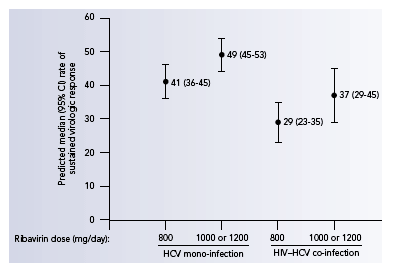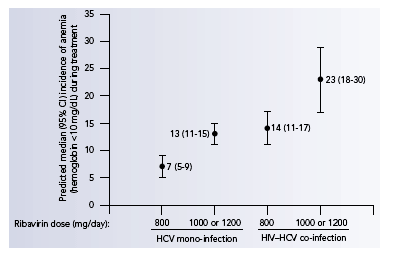 |
 |
 |
| |
Outcomes in HIV-HCV co-infected genotype 1 patients treated with peginterferon alfa-2a (40KD) plus ribavirin 1000 or 1200 mg/day:
predictions based on generalized additive models
|
| |
| |
Reported by Jules Levin
AASLD, Nov 2-6, 2007, Boston, MA
F. Torriani,1 M. Rodriguez-Torres,2 J. Rockstroh,3 E. Snoeck,4 K. Jorga,5 D.T. Dieterich6
1Division of Infectious Diseases, UCSD Infection Prevention and Clinical Epidemiology Unit, San Diego, CA, USA; 2Fundacion de Investigacion de Diego, Ponce School of Medicine, Santurce, Puerto Rico; 3Medizinisdie Klinik I, University of Bonn, Bonn, Germany;
4Exprimo NV, Mechelen, Belgium; 5Roche, Basel, Switzerland; 6Mount Sinai School of Medicine, New York, NY, USA
This research was funded by Roche, Basel, Switzerland.
CONCLUSIONS
Our predictions suggest that increasing the ribavirin dose from 800 mg/day to 1000 or 1200 mg/day would improve SVR rates in patients with HIV-HCV (genotype 1) co-infection.
The gain in SVR would be similar to that obtained in patients with HCV mono-infection.
The predicted SVR rate of 37% is remarkably similar to the 36% SVR rate obtained by Nunez et al. in HIV-HCV (genotype1) patients treated for 48 weeks with peginterferon alfa-2a (40KD) plus ribavirin 1000 or 1200 mg/day in a recent trial.[4]
This simulation, together with data from clinical studies (the ongoing PARADIGM study), could in future, support a recommendation for ribavirin dosing in HIV-HCV co-infection similar to those in mono-infection.[8]
Use of a higher standard dose of ribavirin would be expected to increase the incidence of anemia. In HIV-HCV co-infection, baseline factors predictive of anemia are similar to patients with HCV mono-infection but the incidence of anemia is expected to approximately double in co-infected patients.
Anemia is inherently linked to HIV-HCV co-infection and certain HIV regimens. Although we did not include this as a variable in the analysis, it is possible that with increased choice of antiretroviral regimens, i.e. less use of zidovudine
and stavudine, anemia may occur less frequently than in our model.
Hemoglobin levels should be monitored closely during HCV treatment with combination therapy and, should anemia be detected, the dose of ribavirin decreased in small decrements (i.e. 200 mg/day) to preserve the higher probability of SVR.
INTRODUCTION
The treatment of choice for patients with chronic hepatitis C infection is combination therapy with pegylated interferon plus ribavirin. In patients with HCV genotype 1 mono-infection, a ribavirin dose of 1000 or 1200 mg/day produces significantly higher sustained virologic response (SVR) rates than a dose of 800 mg/day and is recommended in treatment guidelines.[1]
All HIV-HCV co-infected patients enrolled in APRICOT received peginterferon alfa-2a (40KD) plus ribavirin 800 mg/ day for 48 weeks. The low dose of ribavirin was selected because of concerns about tolerability and the potential for drug-drug interactions between ribavirin and nucleoside reverse transcriptase inhibitors (NRTIs). Treatment was well tolerated in the trial,[2] and a substudy showed that the pharmacokinetics of ribavirin and NRTIs were not altered by
co-administration.[3]
The overall rate of SVR in APRICOT was 40%, and in patients with HCV genotype 1 infection the rate of SVR was 29%. Use of a higher standard dose of ribavirin would be expected to increase SVR rates in co-infected patients. This has been confirmed in a non-randomized, open-label study showing higher SVR rates with higher ribavirin doses.[4] Another possible approach is to model the effects of higher ribavirin doses in APRICOT.
OBJECTIVE
The objective of this analysis was to predict the SVR rate and the incidence of anemia in HIV-HCV (genotype 1) co-infected patients after treatment for 48 weeks with the combination of peginterferon alfa-2a (40KD) plus ribavirin 1000 or 1200 mg/day with the aid of existing generalized additive models (GAM) that incorporate data from randomized, international phase III trials.
METHODS
Data
The methods used to establish the GAM are published elsewhere.[5]
The existing SVR model includes data from 817 patients with HCV genotype 1 mono-infection who were treated with peginterferon alfa-2a (40KD) 180 _g/week plus either a low (800 mg/day) or standard dose of ribavirin (1000 mg/day if body weight is ≦75 kg; or 1200 mg/day if body weight is >75 kg) for 48 weeks in two phase III clinical trials.[6, 7]
The existing anemia model includes data from 1233 patients with HCV mono-infection of all genotypes who were treated with peginterferon alfa-2a (40KD) 180 _g/week plus a low or standard dose of ribavirin for 48 weeks in the two trials.[6, 7]
Binary data from the 176 patients with HIV-HCV (genotype 1) co-infection enrolled in APRICOT[2] were incorporated into the existing models for SVR and anemia.
Outcomes
SVR was defined as undetectable serum HCV RNA (<50 IU/mL) by qualitative PCR assay at the end of a 24-week untreated follow-up period (week 72).
For the purpose of the predictions, anemia was defined as a hemoglobin concentration <10 mg/dL documented on at least one occasion during treatment.
Analyses
The effect of prognostic factors on SVR and anemia were analyzed and simulations run with the updated GAM to predict SVR and the incidence of anemia in co-infected genotype 1 patients treated with peginterferon alfa-2a (40KD) plus ribavirin 1000 or 1200 mg/day.
Uncertainty was quantified by 'bootstrapping'.
RESULTS
Among co-infected patients, baseline HCV RNA levels were generally higher, and body weight and the proportions of female patients, Caucasian patients, and patients with cirrhosis were generally lower when compared with monoinfected
patients included in the existing SVR and anemia databases.
SVR predictions
After incorporating data from APRICOT, prognostic factors retained in the model for SVR included baseline HCV RNA level, ribavirin dose (mg/kg), age, baseline ALT quotient, histological diagnosis, and HIV status.
The predictive performance of the GAM model for SVR was successfully qualified as the observed SVR fell within the predicted distribution of the SVR rate.
The magnitude of the increase in SVR rate in HCV genotype 1 patients is predicted to be similar in patients with HCV monoinfection and in patients with HIV-HCV co-infection (Figure 1).
Figure 1. Predicted median (95% CI) rate of SVR after 48 weeks of treatment with peginterferon alfa-2a (40KD) plus ribavirin 800 mg/day or 1000/1200 mg/day in patients with HCV genotype 1 mono-infection and HIV-HCV (genotype 1) co-infection.

The simulations predict that increasing the dose of ribavirin from 800 mg/day to 1000 or 1200 mg/day in patients with HIV-HCV (genotype 1) co-infection would increase the rate of SVR by 8% (from 29% to 37%) (Figure 1).
Anemia predictions
Prognostic factors retained in the model for anemia included hemoglobin level, ribavirin dose (mg/kg), age, sex, HIV status, baseline ALT quotient, and HCV RNA level.
The predictive performance of the GAM model for the incidence of anemia was successfully qualified as the observed incidence of anemia fell within the predicted distribution of the incidence of anemia.
The incidence of anemia in HIV-HCV co-infected patients is estimated to be approximately twice that of HCV monoinfected patients (Figure 2).
Increasing the dose of ribavirin from 800 mg/day to 1000/1200 mg/day is predicted to increase the incidence of anemia from 14% to 23% (Figure 2).
Figure 2. Predicted median (95% CI) incidence of anemia (hemoglobin <10 mg/dL documented on at least one occasion) during 48 weeks of treatment with peginterferon alfa-2a (40KD) plus ribavirin 800 mg/day or 1000/1200 mg/day in patients with HCV genotype 1 mono-infection and HIV-HCV (genotype 1) co-infection.

REFERENCES
1. Dienstag JL, McHutchison JG. American Gastroenterological Association medical position statement on the management of hepatitis C. Gastroenterology 2006; 130(1): 225-30.
2. Torriani FJ, Rodriguez-Torres M, Rockstroh JK, et al. Peginterferon alfa-2a plus ribavirin for chronic hepatitis C virus infection in HIV-infected patients. N Engl J Med 2004; 351(5): 438-50.
3. Rodriguez-Torres M, Torriani FJ, Soriano V, et al. Effect of ribavirin on intracellular and plasma pharmacokinetics of nucleoside reverse transcriptase inhibitors in patients with human immunodeficiency virus-hepatitis C virus coinfection: results of a randomized clinical study. Antimicrob Agents Chemother 2005; 49(10): 3997-4008.
4. Nunez M, Miralles C, Berdun MA, et al. Role of weight-based ribavirin dosing and extended duration of therapy in chronic hepatitis C in HIV-infected patients: the PRESCO trial. AIDS Res Hum Retroviruses 2007; 23(8): 972-982.
5. Snoeck E, Wade JR, Duff F, et al. Predicting sustained virologic response and anaemia in chronic hepatitis C patients treated with peginterferon alfa-2a (40KD) plus ribavirin. Br J Clin Pharmacol 2006; 62(6): 699-709.
6. Fried MW, Shiffman ML, Reddy KR, et al. Peginterferon alfa-2a plus ribavirin for chronic hepatitis C virus infection. N Engl J Med 2002; 347(13): 975-982.
7. Hadziyannis SJ, Sette H, Jr., Morgan TR, et al. Peginterferon-alpha2a and ribavirin combination therapy in chronic hepatitis C: a randomized study of treatment duration and ribavirin dose. Ann Intern Med 2004; 140(5): 346-355.
8. Alberti A, Clumeck N, Collins S, et al. Short statement of the first European Consensus Conference on the treatment of chronic hepatitis B and C in HIV co-infected patients. J Hepatol 2005; 42(5): 615-624.
|
| |
|
 |
 |
|
|